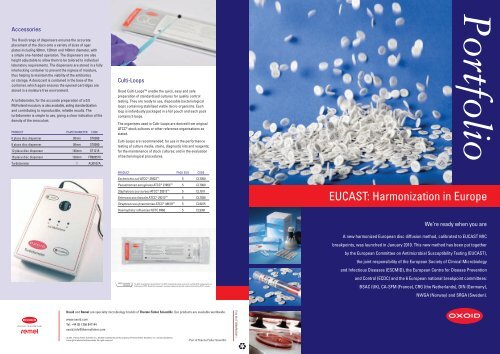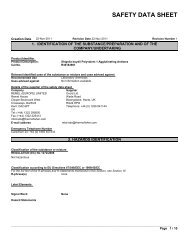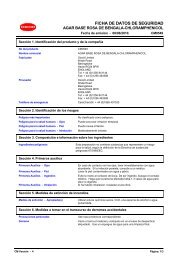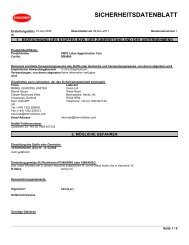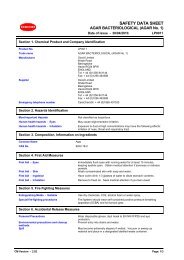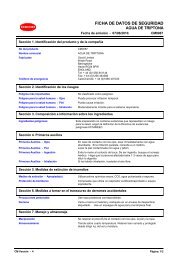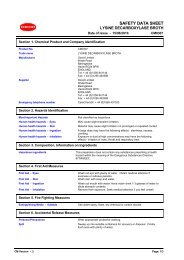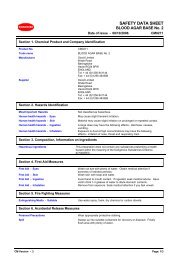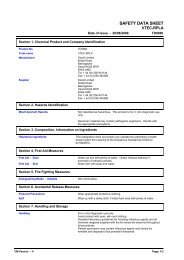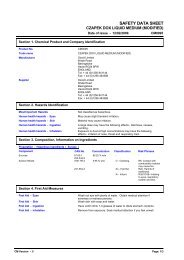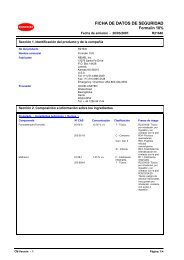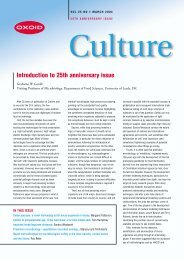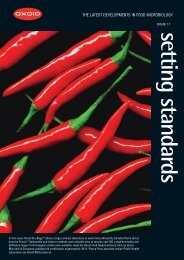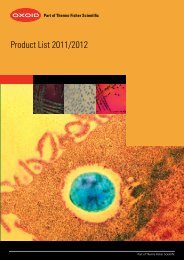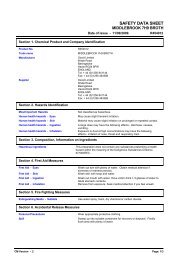Create successful ePaper yourself
Turn your PDF publications into a flip-book with our unique Google optimized e-Paper software.
Accessories<br />
The <strong>Oxoid</strong> range of dispensers ensures the accurate<br />
placement of the discs onto a variety of sizes of agar<br />
plates including 90mm, 120mm and 140mm diameter, with<br />
a simple one-handed operation. The dispensers are also<br />
height adjustable to allow them to be tailored to individual<br />
laboratory requirements. The dispensers are stored in a fully<br />
interlocking container to prevent the ingress of moisture,<br />
thus helping to maintain the viability of the antibiotics<br />
on storage. A desiccant is contained in the base of the<br />
container, which again ensures the opened cartridges are<br />
stored in a moisture free environment.<br />
A turbidometer, for the accurate preparation of a 0.5<br />
McFarland inoculum, is also available, aiding standardization<br />
and contributing to reproducible, reliable results. The<br />
turbidometer is simple to use, giving a clear indication of the<br />
density of the innoculum.<br />
PRODUCT PLATE DIAMETER CODE<br />
6 place disc dispenser 90mm ST6090<br />
8 place disc dispenser 90mm ST8090<br />
12 place disc dispenser 140mm ST1215<br />
16 place disc dispenser 120mm FR600510<br />
Turbidometer 1 AU0107A<br />
DEDICATED TO MICROBIOLOGY<br />
†<br />
Culti-Loops<br />
<strong>Oxoid</strong> Culti-Loops TM enable the quick, easy and safe<br />
preparation of standardised cultures for quality control<br />
testing. They are ready to use, disposable bacteriological<br />
loops containing stabilised viable micro-organisms. Each<br />
loop is individually packaged in a foil pouch and each pack<br />
contains 5 loops.<br />
The organisms used in Culti-Loops are derived from original<br />
ATCC ® stock cultures or other reference organisations as<br />
stated.<br />
Culti-Loops are recommended: for use in the performance<br />
testing of culture media, stains, diagnostic kits and reagents;<br />
for the maintenance of stock cultures; and in the evaluation<br />
of bacteriological procedures.<br />
PRODUCT PACK SIZE CODE<br />
Escherichia coli ATCC ® 25922† 5 CL7050<br />
Pseudomonas aeruginosa ATCC ® 27853† 5 CL7060<br />
Staphylococcus aureus ATCC ® 29213† 5 CL7011<br />
Enterococcus faecalis ATCC ® 29212† 5 CL7030<br />
Streptococcus pneumoniae ATCC ® 49619† 5 CL9015<br />
Haemophilus infl uenzae NCTC 8468 5 CL9391<br />
The ATCC Licensed Derivative Emblem ® , the ATCC Licensed Derivative word mark ® , and the ATCC catalog marks are<br />
trademarks of ATCC. <strong>Oxoid</strong> Ltd is licensed to use these trademarks and sell products derived from ATCC ® ®<br />
cultures.<br />
<strong>Oxoid</strong> and Remel are specialty microbiology brands of Thermo Fisher Scientifi c. Our products are available worldwide.<br />
www.oxoid.com<br />
Tel: +44 (0) 1256 841144<br />
oxoid.info@thermofi sher.com<br />
© 2011, Thermo Fisher Scientifi c Inc. All other trademarks are the property of Thermo Fisher Scientifi c, Inc. and its subsidiaries.<br />
Copyright to photos held separately. All rights reserved.<br />
Part of Thermo Fisher Scientifi c<br />
Folio No LT1336A/MS/03/11<br />
<strong>Portfolio</strong><br />
EUCAST: Harmonization in Europe<br />
We’re ready when you are<br />
A new harmonized European disc diffusion method, calibrated to EUCAST MIC<br />
breakpoints, was launched in January 2010. This new method has been put together<br />
by the European Committee on Antimicrobial Susceptibility Testing (EUCAST),<br />
the joint responsibility of the European Society of Clinical Microbiology<br />
and Infectious Diseases (ESCMID), the European Centre for Disease Prevention<br />
and Control (ECDC) and the 6 European national breakpoint committees:<br />
BSAC (UK), CA-SFM (France), CRG (the Netherlands), DIN (Germany),<br />
NWGA (Norway) and SRGA (Sweden).
Background<br />
The EUCAST was formed in 1997 with the aim of achieving<br />
a European consensus on susceptibility testing to enable<br />
comparability of data and resistance surveillance within the<br />
international community.<br />
The new harmonized disc diffusion method was launched<br />
in 2010, and <strong>Oxoid</strong> has worked closely with the EUCAST to<br />
ensure that it can offer a wide range of products to laboratories<br />
wishing to adopt the new EUCAST methodology. The<br />
EUCAST chairman Professor Gunnar Kahlmeter, states that<br />
he has “thoroughly enjoyed being the chairman of EUCAST”<br />
and cited his greatest achievement as “the European<br />
harmonization of the MIC breakpoints”.<br />
Dr Kahlmeter also stated development of the EUCAST disc<br />
diffusion method as a natural progression of the MIC<br />
harmonization, with the following as key stages in the<br />
development strategy:<br />
1 close consultation with national breakpoint committees to<br />
ensure acceptance of the proposed harmonization<br />
1 subsequent agreement to adopt harmonized, Europe-wide<br />
breakpoints, with the disc diffusion test being selected<br />
as the most appropriate way to ensure that the European<br />
MIC-breakpoints are implemented in European laboratories<br />
1 the recognition, by all committees of ‘species-specifi c<br />
breakpoints’<br />
Within this portfolio, we are pleased to present the <strong>Oxoid</strong><br />
‘EUCAST-ready’ product range.<br />
EUCAST: we’re ready, so that you can be too.<br />
Antimicrobial Susceptibility Test Discs<br />
Disc diffusion remains one of the simplest and most widely<br />
used methods for susceptibility testing. It is an extremely<br />
fl exible technique, with a wide variety of antibiotics and<br />
concentrations available, which can easily be changed as<br />
required. The disc diffusion test not only categorizes<br />
resistant, intermediate and sensitive organisms through<br />
quantitative results, but also provides a visual indication of<br />
the following:<br />
1 Inoculum level<br />
1 Presence of contamination<br />
1 Resistant mutants<br />
1 Beta-lactamase activity<br />
1 Antagonism and synergy between antibiotics<br />
<strong>Oxoid</strong> antimicrobial susceptibility test discs are manufactured<br />
under the quality systems BS EN ISO 9001:2008 and ISO<br />
1345:2003, and to the DIN specifi cations for potency. This<br />
is the tightest international standard specifying that the<br />
concentration must be within 90–125% of the concentration<br />
stated on the disc. Each cartridge is individually sealed with<br />
a desiccant to maintain a moisture level of


